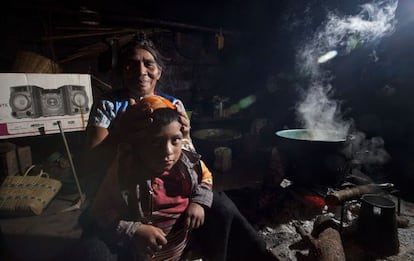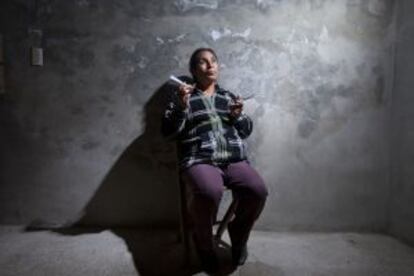Mexico’s indispensable indigenous midwives
More than 3,000 unlicensed women assist with births in poverty-stricken Chiapas state


Micaela kneels before the fire. The smell of burnt wood fills the kitchen, a room with a cement floor and walls barely visible in the faint glow of two light bulbs. Micaela has just the essentials: corn, beans, coffee ... as well as a sound system that stands out among all the traditional kitchenware. The house is located in the middle of the forest, about a 10-minute walk from the highway in San Juan Chamula. It is barely 7am and this 60-year-old woman dressed in traditional garb – petticoat, corset, embroidered shirt – is already preparing the Day of the Dead meal in honor of her late husband. “He was a violent man, he kept an eye on his daughters, he drank and then he would grab his machete to strike us,” she says in her native tzotzil while her grandson drops a few things on the table – bread rolls, Coca-Cola bottles, and posh, a popular alcoholic beverage in this southern Mexico state where peasants led a Zapatista rebellion in 1994. Micaela talks about her husband only to say that she took care of her kids alone, from the moment they were born, delivering her nine births without any help. “That’s how I learned to be a midwife; no one taught me,” she says.
Micaela went through nine births without help. “That’s how I learned to be a midwife; no one taught me”
By now, Micaela has assisted in more than 100 births and continues to make home visits to pregnant patients, many of them in faraway mountain communities where the state’s medical services do not reach. She is not a doctor and has not studied, but she uses herbs, massages, experience, respect and intuition to treat her patients without pills or injections. Her relationship with them is based on trust. Her relationship with the healthcare authorities, on the other hand, is nonexistent. She does not charge for her work or report the births.
“I don’t like the care at the hospital, or cesareans [half of all Mexican babies are born via the procedure]; the women end up very vulnerable.” The government of Chiapas says there are about 3,000 traditional midwives – women who only have hands-on training – in the region, though only 750 are registered. Doctors reject their practice, but their work has been a basic survival tool for a region with scarce resources. The federal government says Chiapas is the second poorest state in the nation; 78.4 percent of its inhabitants live in poverty.

A recent report by the Pan American Health Organization (PAHO), World Health Organization (WHO), United Nations Population Fund, and the Mexican government’s committee on maternity estimated that there would be 3.1 million pregnancies in the country in 2030. Today, only 8,668 of Mexico’s 104,379 reproductive health, maternity and postpartum care professionals are obstetricians and gynecologists – a low number that shows an “urgent need to recruit, train and prepare the maternity care providers the country will need in the next few years.”
The Chiapas health department has created a program to train women and offers them a space where they can work. It also acknowledges the many problems they face. “There is no curriculum that defines their training and many of them don’t speak Spanish, and so need bilingual trainers, which most doctors aren’t,” says Olga López Sánchez, who heads a district midwifery service in Chiapas. The department opened a specialized clinic in San Andrés Larráinzar but they do not assist births there. “The women are on call, but the patients prefer to receive services in their homes, and they only come to the clinic in case of complications.”
The government of Chiapas says there are about 3,000 traditional midwives though only 750 of them are registered
“They choose to give birth at home because that way they don’t leave the kids and the rest of the family,” says Edith López, director of municipal services.
“Going to the hospital involves leaving them for a few days and the administrative process requires spending money. The midwives serve because they believe they have been given a gift and so they don’t ask for payment. Their knowledge has been passed down from generation to generation since the beginning of humanity,” says this 30-year-old woman who splits her time between the touristy city of San Cristóbal and the rural communities. She says the government needs to listen to the community to find out what its priorities are and try to cover them under the healthcare system. NGOs such as Save the Children have developed programs to train and distribute material to improve the care midwives provide to their patients and give them more information.
“One of the options is to certify them based on their level of expertise,” says Olga López. “After training them, the healthcare system should register them and keep them in the system.”
But it is a complicated process, given that their practices clash with Western medicine. Edith López adds: “Whether the government wants it or not, the midwives have been, are, and will always be here to take care of the women of these communities because medical services are scarce.”
Translation: Dyane Jean François
“I am a midwife because I don’t like to see women suffer alone”
María Elena, a 42-year-old mother of six who lives in San Cristóbal, is one of the midwives who recently received training to improve her skills. Her father-in-law taught her how to deliver babies and she practices "because it makes me sad to see women suffer alone," as she herself did. Her birth mother sold her when she was a little girl. "I feel like I have to help," she says. "I was poor and a delivery cost between 8,000 and 10,000 pesos [$560-680] but I did not have it." On the day of our interview she was tired because she had just returned from a home birth. She drove three hours and then walked two more while carrying her equipment because no paved road was available.
As María Elena begins to work she palms the belly of the pregnant woman to find the baby. Then she prepares a herbal tea that speeds up dilation. For the next few hours, she becomes a guide and tells the mom-to-be when to push. Once the baby is born, she holds it with one hand and massages its belly with the other until the placenta, which the father will bury with the umbilical cord, comes out. “The doctors shout: if you could conceive a baby, you can have it.” She knows that doctors don’t acknowledge midwives and feels the care that the women receive is offensive.
Tu suscripción se está usando en otro dispositivo
¿Quieres añadir otro usuario a tu suscripción?
Si continúas leyendo en este dispositivo, no se podrá leer en el otro.
FlechaTu suscripción se está usando en otro dispositivo y solo puedes acceder a EL PAÍS desde un dispositivo a la vez.
Si quieres compartir tu cuenta, cambia tu suscripción a la modalidad Premium, así podrás añadir otro usuario. Cada uno accederá con su propia cuenta de email, lo que os permitirá personalizar vuestra experiencia en EL PAÍS.
¿Tienes una suscripción de empresa? Accede aquí para contratar más cuentas.
En el caso de no saber quién está usando tu cuenta, te recomendamos cambiar tu contraseña aquí.
Si decides continuar compartiendo tu cuenta, este mensaje se mostrará en tu dispositivo y en el de la otra persona que está usando tu cuenta de forma indefinida, afectando a tu experiencia de lectura. Puedes consultar aquí los términos y condiciones de la suscripción digital.
Últimas noticias
The complicated life of Francesca Albanese: A rising figure in Italy but barred from every bank by Trump’s sanctions
Half of Scotland is in the hands of 420 property owners
How Japan is trying to avert ‘digital defeat’
From digital curfews to blocking apps: How technology experts protect their children online
Most viewed
- Why we lost the habit of sleeping in two segments and how that changed our sense of time
- Pablo Escobar’s hippos: A serious environmental problem, 40 years on
- Trump’s obsession with putting his name on everything is unprecedented in the United States
- The Florida Keys tourist paradise is besieged by immigration agents: ‘We’ve never seen anything like this’
- Charles Dubouloz, mountaineering star, retires at 36 with a farewell tour inspired by Walter Bonatti








































